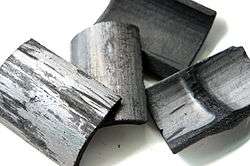Bamboo charcoal

Bamboo charcoal comes from pieces of bamboo plants, harvested after at least five years, and burned in ovens at temperatures ranging from 800 to 1200 °C. It benefits environmental protection by reducing pollutant residue. It is an environmentally functional material featuring excellent absorption properties.
Bamboo charcoal has a long Chinese history, with documents dating as early as 1486 during the Ming dynasty in Chuzhou Fu Zhi. There is also mention of it during the Qing dynasty, during the reigns of emperors Kangxi, Qianlong, and Guangxu.
Production
Bamboo charcoal is made of bamboo by means of a pyrolysis process. According to the types of raw material, bamboo charcoal can be classified as raw bamboo charcoal and bamboo briquette charcoal. Raw bamboo charcoal is made of bamboo plant parts such as culms, branches, and roots. Bamboo briquette charcoal is made of bamboo residue, for example, bamboo dust, saw powder etc., by compressing the residue into sticks of a certain shape and carbonizing the sticks. There are two equipment processes used in carbonization, one is a brick kiln process, and the other is a mechanical process.
Uses
In China and Japan, many people use bamboo charcoal as cooking fuel, as well as to dry tea. Most bamboo charcoal for fuel is bamboo briquette charcoal, and the rest is raw bamboo charcoal. Like all charcoal, bamboo charcoal purifies water and eliminates organic impurities and smells. It is possible to treat chlorine-sterilized drinking water with bamboo charcoal to remove residual chlorine and chlorides. Because he and his team discovered the longevity of its use, Thomas Edison featured a carbonized bamboo filament in one of his original designs for the light bulb.
Bamboo vinegar (called pyroligneous acid) is extracted during production, and is useful for hundreds of treatments in most fields. It contains about 400 chemical compounds and has many applications, including in cosmetics, insecticides, deodorants, food processing, and agriculture.
Some studies claim adding bamboo charcoal or bamboo vinegar to the diets of fish or poultry may increase their growth rates.[1][2]
Health Hazards
As the World Health Organization shows, as with any charcoal, long exposure to bamboo charcoal dust can cause Black Lung as well as some types of coal-related cancers.
The United States Federal Trade Commission warns any company marketing soft linen products as being made from bamboo material (such as bamboo charcoal), is in fact selling rayon products. Producing rayon releases considerable amounts of environmental pollutants, posing significant potential health risks. By illegally mislabelling products as being made from this natural resource, they lure environmentally-conscious consumers into purchasing items made from the very processes they want to avoid.[3][4]
Popular culture
Burger King is using bamboo charcoal as an ingredient in its cheese for a new promotional burger in Japan called the Kuro Pearl and Kuro Ninja burgers.[5]
References
- ↑ "Bamboo charcoal can boost fish growth: study". The China Post. Taiwan. 6 April 2009. Retrieved 11 March 2011.
- ↑ J. Ruttanavut; K. Yamauchi; H. Goto; T. Erikawa (2009). "Effects of dietary bamboo charcoal powder including vinegar liquid on growth performance and histological intestinal change in aigamo ducks" (PDF). International Journal of Poultry. 8 (3): 229–36. ISSN 1682-8356.
- ↑ http://www.consumer.ftc.gov/articles/0122-bamboo-fabrics
- ↑ http://www.ecobabysteps.com/2013/06/25/whats-the-deal-with-charcoal-bamboo
- ↑ http://www.independent.co.uk/life-style/food-and-drink/news/burger-king-releases-black-burger-with-bamboo-charcoal-cheese-and-squid-ink-sauce-in-japan-9724429.html
External links
- Manual of Bamboo Charcoal Production and Utilization by Guan Mingjie of the Bamboo Engineering Research Center (BERC)
- Bamboo Charcoal – Information and How-to guide on making bamboo charcoal